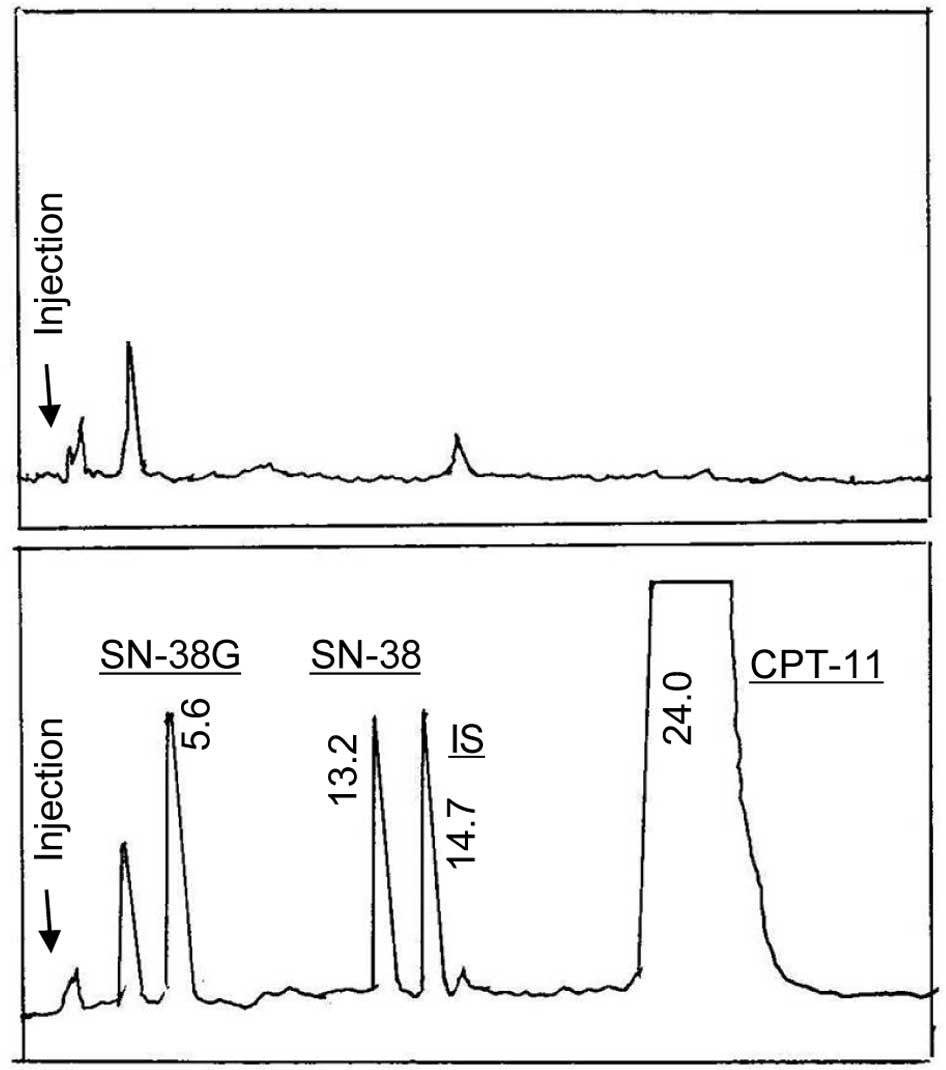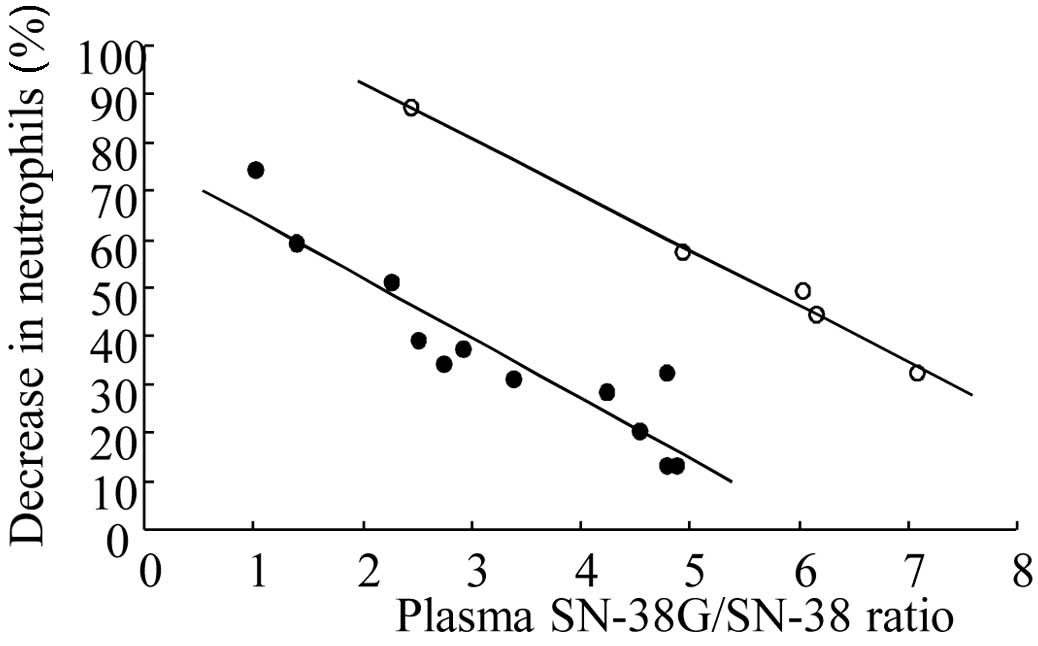|
1
|
Shimoyama S: Pharmacogenetics of
irinotecan: An ethnicity- based prediction of irinotecan adverse
events. World J Gastrointest Surg. 2:14–21. 2010. View Article : Google Scholar : PubMed/NCBI
|
|
2
|
Hasegawa Y, Ando Y and Shimokata K:
Screening for adverse reactions to irinotecan treatment using the
invader UGT1A1 molecular assay. Expert Rev Mol Diagn. 6:527–533.
2006. View Article : Google Scholar : PubMed/NCBI
|
|
3
|
Ratain MJ and Innocenti F: Individualizing
dosing of irinotecan. Clin Cancer Res. 16:371–372. 2010. View Article : Google Scholar : PubMed/NCBI
|
|
4
|
Glimelius B, Garmo H, Berglund A, et al:
Prediction of irinotecan and 5-fluorouracil toxicity and response
in patients with advanced colorectal cancer. Pharmacogenomics J.
11:61–71. 2011. View Article : Google Scholar : PubMed/NCBI
|
|
5
|
Chabot GG, Abigerges D, Catimel G, et al:
Population pharmacokinetics and pharmacodynamics of irinotecan
(CPT-11) and active metabolite SN-38 during phase I trials. Ann
Oncol. 6:141–151. 1995.PubMed/NCBI
|
|
6
|
Chabot GG: Clinical pharmacokinetics of
irinotecan. Clin Pharmacokinet. 33:245–259. 1997. View Article : Google Scholar : PubMed/NCBI
|
|
7
|
Ando Y, Saka H, Ando M, et al:
Polymorphisms of UDP-glucuronosyltransferase gene and irinotecan
toxicity: a pharmacogenetic analysis. Cancer Res. 60:6921–6926.
2000.PubMed/NCBI
|
|
8
|
Innocenti F, Undevia SD, Iyer L, et al:
Genetic variants in the UDP-glucuronosyltransferase 1A1 gene
predict the risk of severe neutopenia of irinotecan. J Clin Oncol.
22:1382–1388. 2004. View Article : Google Scholar : PubMed/NCBI
|
|
9
|
Araki K, Fujita K, Ando Y, et al:
Pharmacogenetic impact of polymorphisms in the coding region of the
UGT1A1 gene on SN-38 glucuronidation in Japanese patients with
cancer. Cancer Sci. 97:1255–1259. 2006. View Article : Google Scholar : PubMed/NCBI
|
|
10
|
Minami H, Sai K, Saeki M, et al:
Irinotecan pharmacokinetics/pharmacodynamics and UGT1A genetic
polymorphisms in Japanese: roles of UGT1A1*6 and *28. Pharmacogenet
Genomics. 17:497–504. 2007.PubMed/NCBI
|
|
11
|
Sai K, Sawada J and Minami H: Irinotecan
pharmacogenetics in Japanese cancer patients: roles of UGT1A1*6 and
*28. Yakugaku Zasshi. 128:575–584. 2008.
|
|
12
|
Mathijssen RH, van Alphen RJ, Verweij J,
et al: Clinical pharmacokinetics and metabolism of irinotecan
(CPT-11). Clin Cancer Res. 7:2182–2194. 2001.PubMed/NCBI
|
|
13
|
Koo DH, Lee JL, Kim TW, et al: A phase II
study of cetuximab plus FOLFIRI for irinotecan and
oxaliplatin-refractory metastatic colorectal cancer. J Korean Med
Sci. 22:98–103. 2007. View Article : Google Scholar : PubMed/NCBI
|
|
14
|
Kurita A and Kaneda N: High-performance
liquid chromatographic method for the simultaneous determination of
the camptothecin derivative irinotecan hydrochloride, CPT-11, and
its metabolites SN-38 and SN-38 glucuronide in rat plasma with a
fully automated on-line solid-phase extraction system, PROSPEKT. J
Chromatogr B. 724:335–344. 1999.
|
|
15
|
Itoh T, Takemoto I, Hata Y, et al:
Determination of the lactone forms and carboxylate forms of
irinotecan and its active metabolite, glucuronide by
high-performance liquid chromatography. Jpn J Ther Drug Monit.
17:383–389. 2000.
|
|
16
|
Takane H, Miyata M, Burioka N, et al:
Severe toxicities after irinotecan-based chemotherapy in a patient
with lung cancer: a homozygote for the SLCO1B1*15 allele. Ther Drug
Monit. 29:666–668. 2007.PubMed/NCBI
|
|
17
|
Nozawa T, Minami H, Sugiura S, Tsuji A and
Tamai I: Role of organic anion transporter OATP1B1 (OATP-C) in
hepatic uptake of irinotecan and its active metabolite,
7-ethyl-10-hydroxycamptothecin: in vitro evidence and effect of
single nucleotide polymorphisms. Drug Metab Dispos. 33:434–439.
2005. View Article : Google Scholar
|
|
18
|
Tanaka H, Saito K, Mino K, et al:
Assessment of total bilirubin or SN-38/SN-38G ratio as a predictor
of severe irinotecan toxicity. Jpn J Cancer Chemother.
36:1505–1509. 2009.PubMed/NCBI
|
|
19
|
Onoue M, Terada T, Kobayashi M, et al:
UGT1A1*6 polymorphism is most predictive of severe neutropenia
induced by irinotecan in Japanese cancer patients. Int J Clin
Oncol. 14:136–142. 2009.
|
|
20
|
Oostendorp RL, van de Steeg E, van der
Kruijssen CM, et al: Organic anion-transporting polypeptide 1B1
mediates transport of Gimatecan and BNP1350 and can be inhibited by
several classic ATP-binding cassette (ABC) B1 and/or ABCG2
inhibitors. Drug Metab Dispos. 37:917–923. 2009. View Article : Google Scholar
|
|
21
|
Marsh S and Hoskins JM: Irinotecan
pharmacogenomics. Pharmacogenomics. 11:1003–1010. 2010. View Article : Google Scholar : PubMed/NCBI
|
|
22
|
Sai K, Saito Y, Maekawa K, et al: Additive
effects of drug transporter genetic polymorphisms on irinotecan
pharmacokinetics/pharmacodynamics in Japanese cancer patients.
Cancer Chemother Pharmacol. 66:95–105. 2010. View Article : Google Scholar
|













